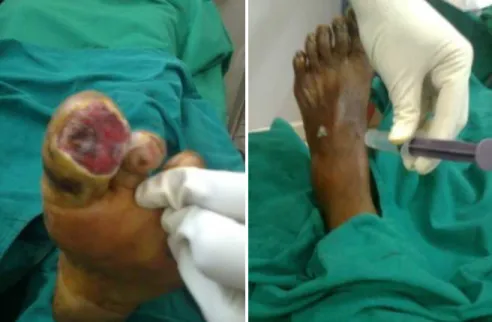ORIGINAL ARTICLE
Journal of Evolution of Medical and Dental Sciences/ Volume 2/ Issue 11/ March 18, 2013 Page-1602
USE OF ANKLE BLOCK AS ALTERNATIVE TO SPINAL ANAESTHESIA FOR
SURGERIES IN DIABETIC FOOT PATIENTS
Pradeep Kumar. S.
1. Assistant Professor. Department of General Surgery, Dr. B. R. Ambedkar Medical College, Bangalore.
CORRESPONDING AUTHOR: Dr. Pradeep Kumar. S, No.108, Shivashakthi Nilaya, 5thcross, 11th main,
B .T .S Layout, Siddedahalli, Bangalore-560073 E-mail: dr.pradeep_k20@yahoo.com
Ph: 0091 919902349960
INTRODUCTION: Diabetes is one of most common co-morbid conditions in our day to day practice. With increasing lifespan, complications like diabetic neuropathy, retinopathy, and diabetic foot are increasing. The last mentioned forms a considerable part of surgical practice; these patients are difficult to manage as they are not fit for any type of anaesthesia as hypertension and cardiac diseases co-exist. It is in these patients that local anaesthesia where ever possible plays an important role. AIM OF STUDY: To study efficacy of ankle block peroperatively and postoperatively in surgeries2,3,5 for diabetic foot. MATERIALS AND
METHODS: 15 patients in age group 40-80years admitted in Dr. B R Ambedkar medical college from Jan 2009-Jan 2010 with diabetic foot were studied of which 9 were males and 6 were females. INCLUSION CRITERIA: Diabetic patients below grade 4 1;Those willing for ankle block
; Those who are unfit for spinal anaesthesia EXCLUSION CRITERIA: Those above grade 41 and
those not willing for ankle block.
KEY WORDS: ankle block,spinal anaesthesia,diabetic foot
TECHNIQUE OF ANKLE BLOCK: Surgical parts painted and draped, 10ML of 2% Xylocaine diluted to 20ML with distilled water and 5ML is injected medial to dorsalis pedis pulsations; 5ml below medial malleolus along direction of flexor retinaculum; 5ml above medial malleolus around long saphenous vein and 5ml below lateral malleolus
Our study included 15 patients, 9 of them (60%) were males (Tables 1 and 3); majority 40% were in age group 51-60(Table 2); out of 15 patients, 12(80%) underwent debridement5,
2(13.3%) had toe disarticulation and 1 had forefoot amputation4 (Table 4); 14(93.3%) patients
tolerated procedure well,1 patient complained of pain and required sedation to complete procedure(Table 5).
Among co-morbid conditions, 6 patients (40%) had hypertension and cardiac disease;5 patients(33.3%) had hypertension alone(Table 6).
DISCUSSION: With increasing lifespan, complications like diabetic neuropathy, retinopathy, and diabetic foot are increasing. The last mentioned forms a considerable part of surgical practice; these patients are difficult to manage as they are not fit for any type of anaesthesia as hypertension and cardiac diseases co-exist. It is in these patients that local anaesthesia where ever possible plays an important role
ORIGINAL ARTICLE
Journal of Evolution of Medical and Dental Sciences/ Volume 2/ Issue 11/ March 18, 2013 Page-1603
control, furthermore other co-morbid illness like obesity, hypertension, cardiac problems are more in diabetics and hypotension induced by spinal anaesthesia could be detrimental. Further the stress of general anaesthesia can aggravate cardiac problems. Regional anaesthetic blocks are safe and effective methods that do not produce any serious hemodynamic disturbances, therefore local blocks are always safer.
CONCLUSION: Even though spinal anaesthesia is used routinely for diabetic foot patients, ankle block can be used effectively in certain patients especially those with co-morbid diseases like hypertension, obesity and cardiac disease.
REFERENCES:
1. Shor NA [Clinical classification of diabetic foot syndrome]. [English Abstract, Journal Article] Klin Khir 2011 Sep; (9):55-7.
2. Jirkovská A [Adherence to the international guidelines on the treatment of diabetic leg syndrome]. Vnitr Lek 2011 Nov; 57(11):908-12.
3. López Herranz M, Bas Caro P, Carabantes Alarcón D, et al.[Therapeutic uses of ortho- podiatry in the diabetic foot]. [English Abstract, JournalArticle] Rev Enferm 2011 Oct; 34(10): 30-9.
4. Tosun B, Buluc L, Gok U, et al.Boyd amputation in adults. [Journal Article] .Foot Ankle Int 2011 Nov; 32(11):1063-8
5. Gordon KA, Lebrun EA, Tomic-Canic M, et al. The role of surgical debridement in healing of diabetic . Foot ulcers. [Journal Article, Review] Skinmed 2012 Jan -Feb; 1
Table 1-Patient characteristics
Serial no. Age Sex Limb affected Co-morbid illness Procedure undergone
1 47 M R O,H,C D
2 54 F L H D
3 52 M L O,H D
4 77 M R H D
5 63 M L H,C D
6 74 F R O,H T
7 79 F L H D
8 57 M R H,C D
9 65 F R H,C T
10 59 M L O,H D
11 62 M R H FA
12 60 F R H D
13 61 M L H,C D
14 51 M L H,C D
15 50 F R H,C D
INDEX M-MALE F-FEMALE R-RIGHT L-LEFT O-OBESITY H-HYPERTENSION C-CARDIAC DISEASE D-DEBRIDEMENT T-TOE DISARTICULATION
ORIGINAL ARTICLE
Journal of Evolution of Medical and Dental Sciences/ Volume 2/ Issue 11/ March 18, 2013 Page-1604
Table 2 -Distribution of patients according to age of the patients Age Group Number of patients(%)
Mean age group=60.7yrs,SD=±9.38 41-50 2(13.3)
51-60 6(40.0) 61-70 4(26.7) 71-80 3(20.0) TOTAL 15
Table 3- Distribution of patients according to sex of the patients Sex of the patient Number of patients
Male 9(60.0%) Female 6(40.0%)
Total 15
Table 4-Distribution of patients according to the type of surgery Type of surgery Number of patients
Debridement 12(80%) Toe disarticulation 2(13.3%) Fore foot amputation 1(6.7%)
Total 15
Table 5-Distribution of patients according to patient compliance Type of patient
compliance
Number of patients
Tolerated well 14(93.3%) Complained of pain 1(6.7%)
Total 15
Table 6-Distribution of patients according to their co-morbidity status Co-mobidity status Number of patients (%)
Hypertension 5(33.3) Hypertension&cardic disease 6(40.0) Hypertension &obesity 3(20.0) Hypertension,obesity&
cardiac disease
1(6.7)
ORIGINAL ARTICLE
Journal of Evolution of Medical and Dental Sciences/ Volume 2/ Issue 11/ March 18, 2013 Page-1605
Fig 1: Diabetic foot ulcer Fig 2: 5ML is injected medial to medial To pedis pulsations


